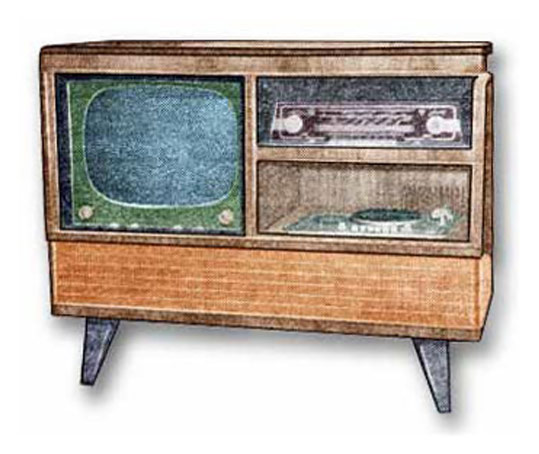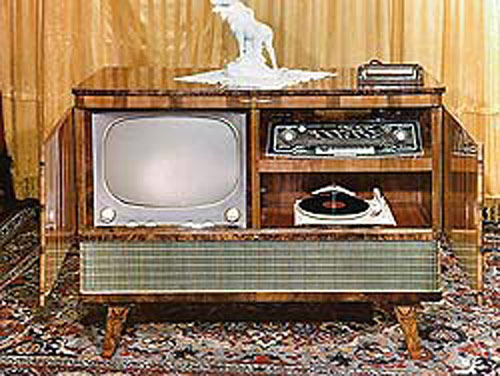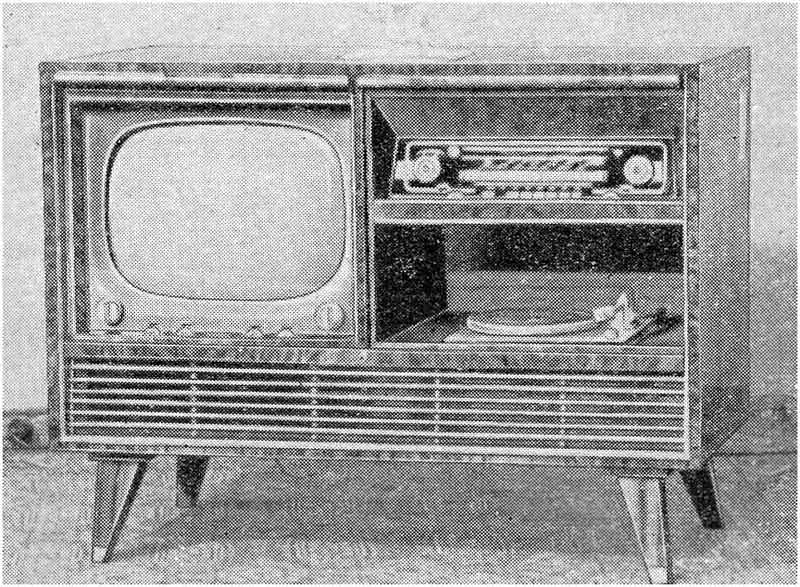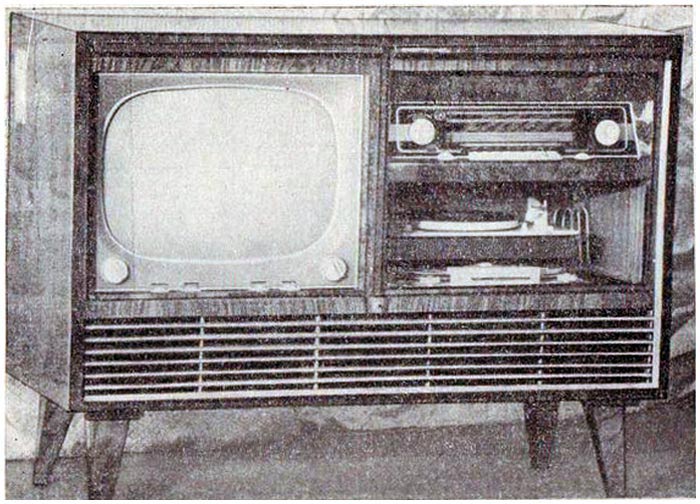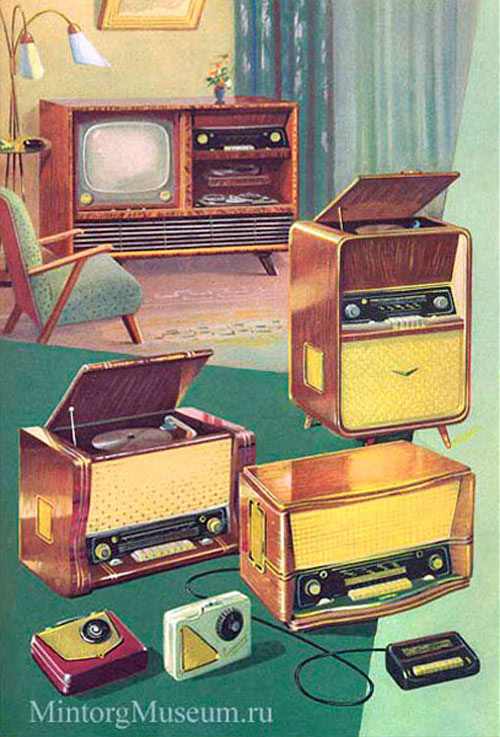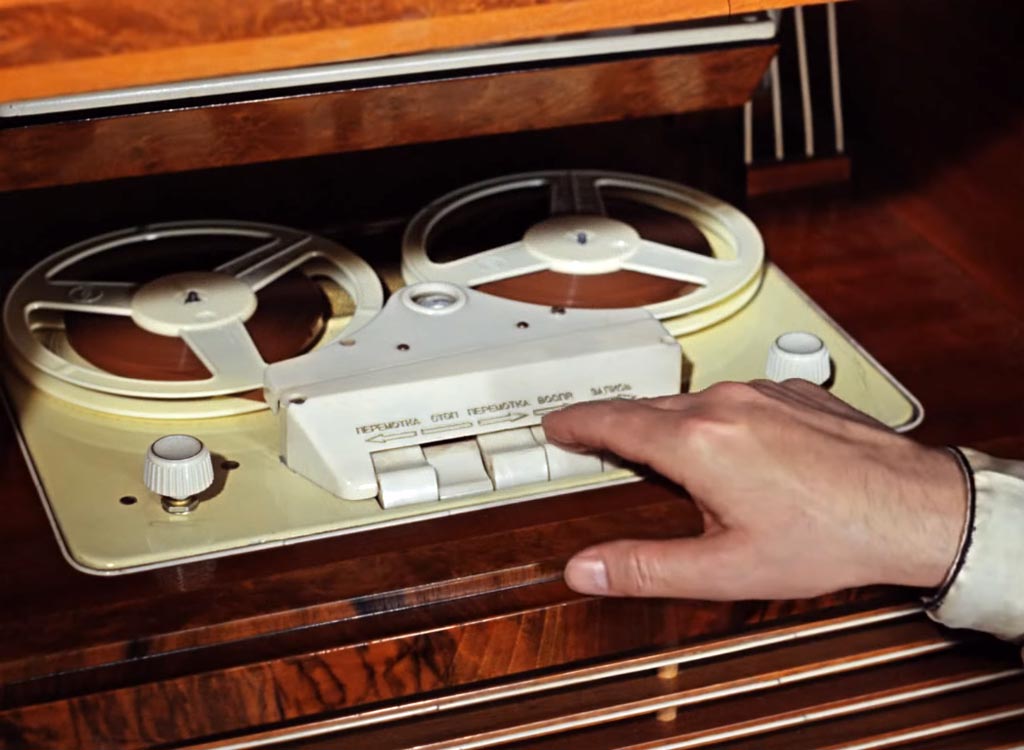Combined installation Kristall-104.
Combined apparatus.Since the fall of 1958, the Kristall-103 combined installation has been produced by the Moscow Television Plant. She combined the Rubin-102 TV; radio receiver "Lux" and tape recorder with universal EPU - "Yauza". 120 installations were produced, including 82 installations already referred to as `` Crystal-104 ''. Since the spring of 1959, the plant has produced 280 Kristall-104 installations with an EPU, but without a tape recorder, and in some installations an electric player was installed with an automatic change of records. The installation received a more modern design. The described installations had 17 radio tubes and 11 diodes. Their speakers have 4 loudspeakers each. Rated output power 3 W. The range of reproducible frequencies when receiving FM 60 ... 12000 Hz, AM 80 ... 4000 Hz, TV - 80 ... 10000 Hz, during operation of EPU 100 ... 7000 Hz, tape recorder 70 ... 7000 Hz. Since the spring of 1959, a batch of 180 Kristall-104 installations was also released in which a new TV was installed, and in addition to the EPU and a two-track tape recorder Elfa-10. This is how the exhibition (at VDNKh) sample of the Kristall-104 combined installation, produced in 1959, was described. Installation "Kristall-104" refers to high-class TV and radio systems and has furniture design. The installation contains a TV set, a radio receiver, an electric player and a tape recorder. In the upper left part of the installation case, there is an Almaz-102 TV with a 53LK2B kinescope and an image size of 340x450 mm. In the upper right part of the case, there is a high-class all-wave radio receiver "Lux". A universal player is located under the receiver, which, when used, drops down a little and moves forward. A tape recorder of the "Elfa-10" type is located below the electric player. In the lower compartment, closed with a decorative grille, there are LF and HF loudspeakers and a powerful two-channel, frequency-separated amplifier. In a batch of installations, the case had two sliding doors covering the front of the device. By sliding one such door towards the other, it was possible to open access to the TV or to the receiver, tape recorder and turntable. A powerful ULF with a broadband speaker was common for a TV, receiver, turntable and tape recorder. The main handles are brought out to the front of the case, the auxiliary ones are located on the back wall. The Elfa-10 tape recorder is designed for two-track recording at a speed of 19 cm / sec. The duration of the operation of the tape recorder with a cassette filled with magnetic tape is equal to one hour for two-track use. The band of recorded and reproduced frequencies is 50 ... 10000 Hz. The transition from one track to another is carried out by rearranging the cassette from the left side to the right. The recording level is controlled by an optical indicator. Tone control is performed only in the treble area. The tape recorder is equipped with a dynamic microphone "MD-41" and three cassettes, two of which are filled with a type 2 ferromagnetic tape. Universal electric player with hitchhiking, designed for playing regular and LP records. The ZPU-M piezoelectric pickup with a corundum needle has an AFC from 70 to 10,000 Hz. The sound pressure developed by the acoustic unit is 20 bar. The band of reproducible frequencies is 50 ... 12000 Hz. THD does not exceed: at medium frequencies 7%, at high frequencies 5%. The unit is powered by an alternating current network with a frequency of 50 Hz and a voltage of 110, 127 or 220 V. Power consumption from the network when the TV is running 230 W; TV and tape recorder 280 W; receiver and tape recorder 200 W; receiver or EPU - 160 W; tape recorder 140 watts. All the installations described were produced either with doors covering the front of the apparatus, or without doors, or with one wooden shutter covering the inoperative part of the installation. In the comedy film "Prisoner of the Caucasus", the described combined installation "Crystal-104" produced in 1959 is shown, in a scene at Comrade Saakhov's dacha, where G. Vitsin, Yu. Nikulin and N. Varley perform a Caucasian dance. In the frame, a wooden curtain is clearly visible, covering the inoperative TV.